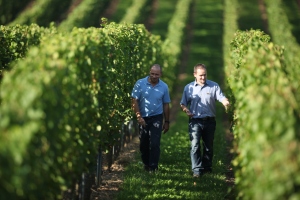
Porto
It’s rare when you visit a place you immediately fell in love with for the second time and feel the same rush. My recent trip to Porto and the Douro Valley was all that and more with still-recurring wistful feelings of “saudade”, the haunting Portuguese word (not translatable in English) for longing for something or someone that is no longer near you.
Besides the eye-grabbing adobe-topped buildings of Porto
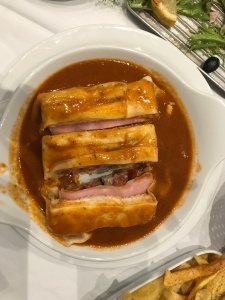
Francesinha sandwich
and the sweeping beauty of the Douro River, Porto offers a wealth of richness in cuisine, dry wines (not just Port), and incredible culture and history. I had no idea what a gastronomic place Porto is: teeming with fresh fish and vegetables, amazing bread, cheese, and sausages, and my new favorite splurge meal – the francesinha sandwich. The latter is a seemingly crazy blend of beef, pork, and ham smothered with cheese and a tomato-based sauce made of whiskey, bourbon, wine, and beer. While it sounds bizarre, it’s truly incredible and ends up tasting somewhat like a spicy barbecue sauce atop a pizza burger.
Portugal is, of course, best known for its world-renowned Port, a fortified sweet drink made in both wood and bottle-aged styles. The history of Port is one of the most unique wine stories around dating back to the mid-17th century. The grapes were grown 70 miles up the Douro River in the Douro Valley where they were also made into base wines for Port using traditional processes of foot-treading in granite lagares and fortification with 77% alcohol grape spirit to preserve some sugars thus creating Port’s natural sweetness.

Granite Lagares
The wines were stored for the winter and then, when spring arrived, the wines were shipped down the Douro River to Vila Nova de Gaia in precarious flat-bottomed boats called barcos rabelos. Many lives and Port barrels were lost in these journeys due to the turbulent Douro River (which has since been dammed up in several places to allow easier passage). Vila Nova de Gaia offered higher humidity and cooler temperatures that allowed the Port to age better.
Today these same processes continue except trucks are used instead of boats and some quintas (estates or vineyards) such as Quinta do Noval choose to store their Ports long-term in the Douro since temperature-controlled rooms and tanks are available now. Port lodges dot the banks of the Douro River (as do rabelo boats) providing a timeless yet historical backdrop to a thriving and vibrant town.

Rabelo boats
Fascinatingly, the same grapes that go into Port (commonly Touriga Nacional, Touriga Franca, Tinta Cao, Tinta Barroca, and Tinta Roriz (aka Tempranillo) are also used to produce robust and characterful red wines. Conversely, White Port also exists and its grapes (Rabigato, Gouveio, Arinto, and Boal among many others) produce intriguingly full-bodied and complex white wines. Rosé is also fabulous, typically made from Touriga Nacional, arguably the Douro’s flagship grape (said to be like Cabernet Sauvignon is to Napa, CA).
A few side-notes on Porto before we get to the wines. Not only is it blessed with jaw-dropping natural beauty, Porto is very clean with a safe and almost pristine feel to it. Independent vendors line the streets paralleling the Douro river peddling unique wares including cork purses and wallets, hand-carved figures, and all kinds of vividly-colored textiles which Portugal is known for. Each Portuguese region has its own textile design and colors. It’s a kind of daily market which, while a bit touristy, owes its authenticity to the fine workmanship in most of the things I saw. Another thing that struck me is no matter what you buy or where you buy it, the attention to attractive packaging is always there (and there’s no bag cost).

The Yeatman
Speaking of attractive, if you can splurge, consider staying at the fabulous Yeatman hotel in Porto.

The Yeatman Room
Owned by The Fladgate Partnership, the hotel is a shrine to the wines of Portugal. Each spacious and impeccably-decorated room offers a patio overlooking the Douro River. The hotel offers world-class dining in the Gastronomic Restaurant (2 Michelin stars) and a literally perfect bar (Dick’s Bar) featuring fascinating Portuguese wines, mesmerizing views, and the kind of aura that makes you want to stay all night and ponder the world. There’s also a lovely spa, infiniti pool, gym, and unparalleled service by every single employee I spoke with from the breakfast servers to the concierge, bar staff, and events team.

Taylor Fladgate’s Port Lodge
The Yeatman lies on the Vila Nova de Gaia side of the river along with all of the Port lodges.

Ramos Pinto Port Lodge
The Port lodges are charming time capsules of wine history and lore. Most offer guided tours, tastings, and occasionally even Fado (the traditional Portuguese music) concerts such as the one at Cálem. If you haven’t had much Port you may think they all taste alike but this couldn’t be further from the truth. Each Port house has its own style, blending, and aging regimen which is easily evident when the various Ports are lined up side by side.
We spent time at Taylor Fladgate’s lodge as well as Graham’s lodge in Porto. The Fladgate Partnership owns the Taylor Fladgate, Fonseca, and Croft brands and chooses to only make Port (they don’t make any dry wine but they do partner with several quintas that do). The Symington Family owns Dows, Warres, Graham’s, Cockburn, and Optima among several brands.

Taylor Fladgate tour display
At Taylor Fladgate, we did a wonderful self-guided tour (which I had initial doubts about) as well as a world-class tasting. Last time I visited, our Masters of Wine group had an amazing tour done by Adrian Bridge himself (CEO of Taylor Fladgate) but obviously that model doesn’t scale so we were told that the new self-guided tour was created to insure content consistency and also to allow visitors to experience what interested them most.
During the tour, we saw the expansive Port cellars, a complete life cycle demonstration of grapes budding to being made into Port, soil and rock samples of the incredible Douro schist terraces, and several videos explaining how Port is made. I asked several people at the end how they liked the tour and all said they absorbed more from going at their own pace than listening to a guide so it appears the self-guided tour was a winner. I enjoyed it as well although I have to say it’s hard to beat Mr. Bridge’s historical accounts and vast knowledge of the Douro region.

Taylor Fladgate barrel
Afterward we had a brilliant tasting of the 7 Ports below:
Late Bottled Vintage (LBV)– these are Ports made from a single vintage and aged 4 -6 years in wood. This style is aimed at earlier drinking and offers great value for the quality as it’s like a Vintage but much more affordable. This one tasted very fruit-forward with black and red fruit at the forefront and round soft tannins balancing out zesty acidity.
2012 Quinta da Vargellas Vintage – Vargellas is the enchanting vineyard located far east in the Douro Superior that provides grapes for the Taylor Fladgate Ports. These grapes have vibrant acidity and natural tension as a result of their home at higher altitudes. This Port is a Single-Quinta Vintage Port which means that all grapes came from the same year and vineyard and that it was primarily aged in bottle (only two years in wood) which produces the deep opaque purple that is characteristic of Vintage ports. Bottle aging prevents oxygen from getting into the wine thus preserving the deep color and producing more fruit–forward flavors. Flavors of blackberry, blueberry, chocolate, and violet with an electric acidity showcase this Port.
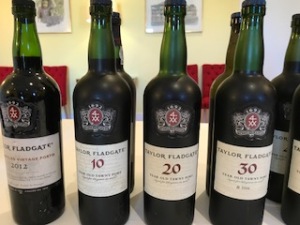 10 Year Tawny – A tawny is aged at least 6 years in wood and the “10 year” designates that the average age of all wines used in the blend is 10 years old. Tawnies are always blends of many different years and always lighter in color than Vintage Ports due to slight oxygen ingress from being aged in barrel which also produces a more dried fruit and nut profile versus the fruitiness of a Vintage. This Port was the darkest in color of the 5 tawnies and tasted of dried fruit, spice, and almonds.
10 Year Tawny – A tawny is aged at least 6 years in wood and the “10 year” designates that the average age of all wines used in the blend is 10 years old. Tawnies are always blends of many different years and always lighter in color than Vintage Ports due to slight oxygen ingress from being aged in barrel which also produces a more dried fruit and nut profile versus the fruitiness of a Vintage. This Port was the darkest in color of the 5 tawnies and tasted of dried fruit, spice, and almonds.
20 Year Tawny – Charming flavors of orange peel, dried apricot, marmalade, and walnuts with supple tannins and that lightning acidity to keep it fresh. This was the most universally popular of the bunch. In general, 20 Year tawnies offer the best value for the quality as they are substantially more complex than a 10 Year and typically not much higher in price.
30 Year Tawny – This Port demonstrated the developing signs of age with notes of acetaldehyde (that “sherry-like” smell) accompanied by polished mahogany, dried pineapple, and orange flavors with a highly viscous mouthfeel. Most port houses don’t make 30 and 40 year-old Ports anymore and it’s a category that Taylor Fladgate excels at.
40 Year Tawny – Making the leap of preserving the 20 Year tawny’s freshness and youthful acidity but combining those wonderful age flavors of dried fruit, prune, and walnuts that started to appear in the 30 year-old, this Port was exceptional with brisk acidity and regal structure.
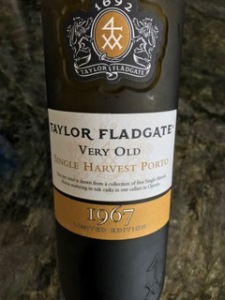 1967 Colheita – Colheita is a vintage tawny Port which means that it’s aged at least 6 years in wood (like a Tawny) but is made from grapes all harvested in the same year (like a Vintage). All of these grapes were from 1967 which I have a special fondness for as it’s my birth year and I used this Port to celebrate the big 5-0 earlier this year.
1967 Colheita – Colheita is a vintage tawny Port which means that it’s aged at least 6 years in wood (like a Tawny) but is made from grapes all harvested in the same year (like a Vintage). All of these grapes were from 1967 which I have a special fondness for as it’s my birth year and I used this Port to celebrate the big 5-0 earlier this year.
This Port was a complex menagerie of maple syrup, caramel, honey, walnuts, dried herbs, and furniture polish with an almost Cognac-like edge to it. Its beautiful amber gold color was tinged with olive flecks on the rim which also speaks to its age. 11,000 bottles were produced and this Port can still be found in the U.S. for $300.
Taylor Fladgate also has a beautiful restaurant next to the tasting room called Barão Fladgate. With a panaoramic patio and spectacular views from inside, this is a perfect place to enjoy everything Porto has to offer.
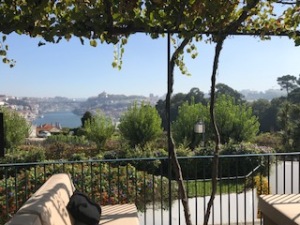
Vinum Restaurant
We also visited Graham’s Lodge in Porto which has a stunning restaurant in Vinum. Sweeping views of the city and Douro river abound whether indoors in the sultry wine-themed interior or the spacious veranda. We had a guided tour of the elaborate cellars (a typical “smaller” Port barrel is 550-liters in size compared to the typical French 225-liter barrel) and more oval shaped in the middle. New oak is rarely used in Port as the competing wood flavors would detract from Port’s own decadent nuances.

550 liter barrel
At Graham’s we tasted a flight of 4 Ports:
Six Grapes Ruby – early-drinking Port with youthful energy and concentrated blackberry and violet notes. The “Six Grapes” name comes from the symbol traditionally used to mark barrels containing the highest quality wine from Graham’s Douro Valley quintas. This Port is primarily made of Touriga Nacional, Touriga Franca, Tinta Roriz, and Tinta Barroca.
Graham’s 10 Year Tawny – Amber gold in color with flavors of red fruit, caramel, and slight nuttiness developing. Robust tannins and firm structure.

Graham’s Lodge Tasting
Graham’s 20 Year Tawny – Smoother tannins with dried apricot, savory herb, and walnut flavors backed by lively acidity.
Warre’s 1980 Vintage Port – Warre’s is one of the drier (less sweet) styles of Port and consequently one of my favorites. This one had pronounced mineral flavors of slate and wet rock, accompanied by Touriga Nacional’s trademark violet and blackberry notes all riding a cascading wave of vibrant acidity.
Unlike the Fladgate Partnership, the Symington Family does make its own dry wines from the same grapes that go into Port. Keep in mind that Port is one of the most highly regulated wines in the world with only a certain percentage of grapes produced allowed to be made into Port each year. The thought (smartly) occurred to someone along the way that those grapes not going into Port were far too good to be wasted thus dry wines were born.
Symington has many wine brands and we tried these two over lunch at Vinum.
2016 Altano which is an organic wine of mixed grape varieties aged in French oak. Fresh and fruity with lush blackberry, spice, and vanilla, this wine is young and vibrant.
Note: the 2015 vintage of this wine just got written up in Decanter’s November issue.
 2014 Altano Reserva is a blend of 90% Touriga Nacional and 10% Touriga Francesca aged in American oak. This was my favorite of the two with lovely notes of cassis, blackberry, and violet supported by smooth tannins and racy acidity. This wine went perfectly with the rib-eye steak that we had for lunch.
2014 Altano Reserva is a blend of 90% Touriga Nacional and 10% Touriga Francesca aged in American oak. This was my favorite of the two with lovely notes of cassis, blackberry, and violet supported by smooth tannins and racy acidity. This wine went perfectly with the rib-eye steak that we had for lunch.

Douro Valley
Next up, our time in the spectacular Douro Valley.


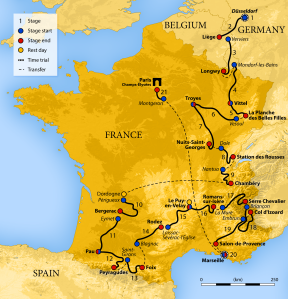

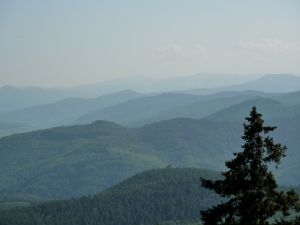

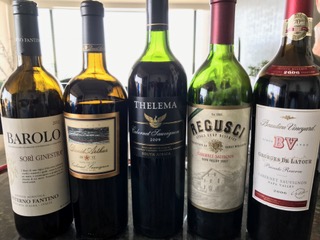 So what does one drink when hitting a milestone birthday like the big 5-0? I looked back through my wine log of the many wines I’ve tried through the years and realized my tastes have changed along with my aging body. When I started drinking wine, without knowing why, I tended toward fruit-forward big red wines. That’s a rather typical American red-wine drinker profile (for my age) as it’s what I grew up on and a style that comes naturally from our “warmer” climate.
So what does one drink when hitting a milestone birthday like the big 5-0? I looked back through my wine log of the many wines I’ve tried through the years and realized my tastes have changed along with my aging body. When I started drinking wine, without knowing why, I tended toward fruit-forward big red wines. That’s a rather typical American red-wine drinker profile (for my age) as it’s what I grew up on and a style that comes naturally from our “warmer” climate.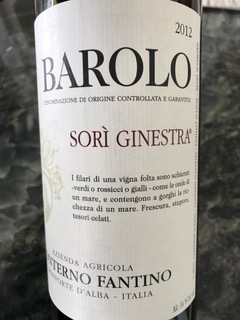
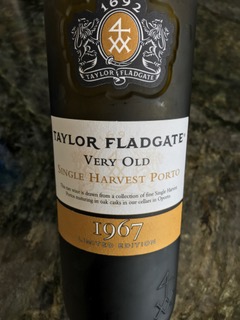 1967 Taylor Fladgate Very Old Single Harvest Porto
1967 Taylor Fladgate Very Old Single Harvest Porto 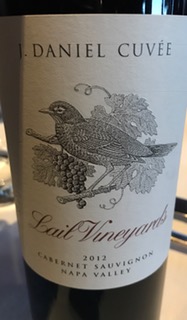 2012 Lail J. Daniel Cuvee Cabernet Sauvignon
2012 Lail J. Daniel Cuvee Cabernet Sauvignon 2013 Vineyard 7/8 Estate Cabernet Sauvignon Spring Mountain
2013 Vineyard 7/8 Estate Cabernet Sauvignon Spring Mountain
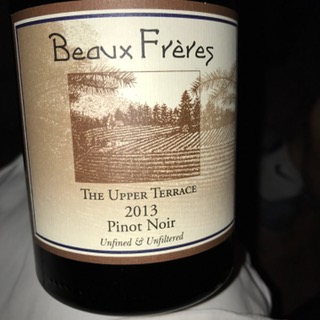
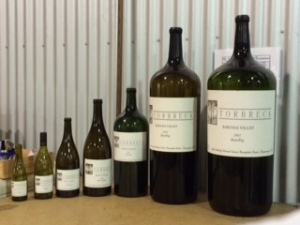
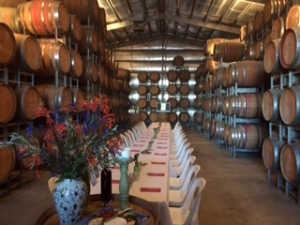 That evening we went to Tait Wines. Set back among rugged hills, this was another highlight of the trip. The Tait family did a huge barbeque for us and we ate in their beautifully decorated cellar barn. It was charming, quaint, traditional, and wonderfully casual. We got to watch the meat come right off the grill while sipping through the Tait product line and talking with the entire Tait family (including their two enchanting children). The Tait wines are also powerful and robust and are aimed at the American palate. My favorites here were the 2014 Border Crossing Shiraz and the Liquid Gold Fronti, a Port-like wine made from Frontignan grapes for only $20. There are not many places where the hostess and winery owner (Michelle Tait) is out picking the table arrangements herself and the winemaker owner (Bruno Tait) is making his own pies for us to try. It was a truly special visit.
That evening we went to Tait Wines. Set back among rugged hills, this was another highlight of the trip. The Tait family did a huge barbeque for us and we ate in their beautifully decorated cellar barn. It was charming, quaint, traditional, and wonderfully casual. We got to watch the meat come right off the grill while sipping through the Tait product line and talking with the entire Tait family (including their two enchanting children). The Tait wines are also powerful and robust and are aimed at the American palate. My favorites here were the 2014 Border Crossing Shiraz and the Liquid Gold Fronti, a Port-like wine made from Frontignan grapes for only $20. There are not many places where the hostess and winery owner (Michelle Tait) is out picking the table arrangements herself and the winemaker owner (Bruno Tait) is making his own pies for us to try. It was a truly special visit.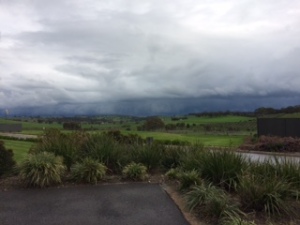
 Remember that driving rain I mentioned earlier? Well it continued through the rest of the trip. Turns out we were there during a rare early spring storm and most of the year’s rain fell in just a few days. The rain and harsh winds added a nostalgic character to the visit for me as I love rainy days and The Louise was just the place to hunker down by the fireplace and drink some Aussie Port. Also in such a water-challenged place as Australia, it’s hard to not appreciate water when it comes naturally.
Remember that driving rain I mentioned earlier? Well it continued through the rest of the trip. Turns out we were there during a rare early spring storm and most of the year’s rain fell in just a few days. The rain and harsh winds added a nostalgic character to the visit for me as I love rainy days and The Louise was just the place to hunker down by the fireplace and drink some Aussie Port. Also in such a water-challenged place as Australia, it’s hard to not appreciate water when it comes naturally.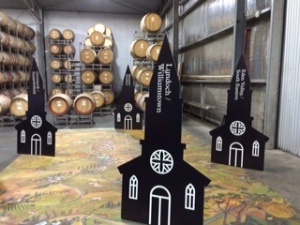 Our final Barossa stop was at the lovely St. Hallett. We tasted through about 15 wines here including Riesling, Semillon, Sauvignon Blanc, Shiraz, and Cabernet Sauvignon. The 2010 St. Hallett Blackwell Shiraz was a group favorite as was the 1996 Old Block Shiraz. We also did a blending exercise which is always fascinating. We used three vats of different wines and combined them into our own wines. This is a lot harder than it sounds and gives one a great appreciation for how hard it is to make a good wine.
Our final Barossa stop was at the lovely St. Hallett. We tasted through about 15 wines here including Riesling, Semillon, Sauvignon Blanc, Shiraz, and Cabernet Sauvignon. The 2010 St. Hallett Blackwell Shiraz was a group favorite as was the 1996 Old Block Shiraz. We also did a blending exercise which is always fascinating. We used three vats of different wines and combined them into our own wines. This is a lot harder than it sounds and gives one a great appreciation for how hard it is to make a good wine.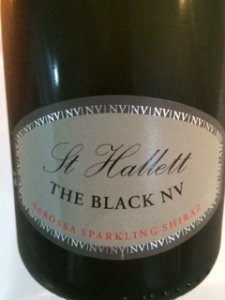 Anne Marie Wright, one of the winemakers here, was wonderfully effusive and knowledgeable explaining the nuances of all of the wines to us. She is also a Scottish transplant, one of many to visit Australia only to never leave.
Anne Marie Wright, one of the winemakers here, was wonderfully effusive and knowledgeable explaining the nuances of all of the wines to us. She is also a Scottish transplant, one of many to visit Australia only to never leave.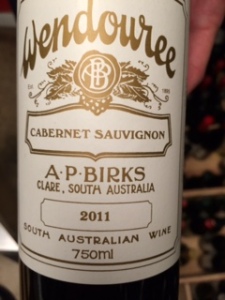 Australia was full of surprises, rugged and graceful beauty, and incredible wines. The many different expressions of Shiraz and Cabernet Sauvignon were astounding and impossible to lump into one style. We barely scratched the surface of this huge continent and we have many reasons to go back. One of those is the Wendouree Cabernet Sauvignon I mentioned before. This wine is from Clare Valley (north of Barossa) and is apparently a small production cult wine in Australia whose owners sell by mail-order only and don’t like attention to the point that they have no website, no tasting room (called cellar door in Australia), and not even an email address. One must call or write a physical letter in order to communicate and even then, there is a long waiting list for their wine.
Australia was full of surprises, rugged and graceful beauty, and incredible wines. The many different expressions of Shiraz and Cabernet Sauvignon were astounding and impossible to lump into one style. We barely scratched the surface of this huge continent and we have many reasons to go back. One of those is the Wendouree Cabernet Sauvignon I mentioned before. This wine is from Clare Valley (north of Barossa) and is apparently a small production cult wine in Australia whose owners sell by mail-order only and don’t like attention to the point that they have no website, no tasting room (called cellar door in Australia), and not even an email address. One must call or write a physical letter in order to communicate and even then, there is a long waiting list for their wine.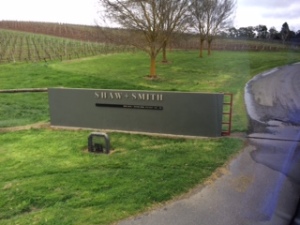 We flew from Melbourne to Adelaide (two hours west) for the second leg of our Australia trip which focused on McLaren Vale. McLaren Vale has a bit of a surfer vibe being only 15k from the ocean along with expansive rolling hills. Our first visit there was at Shaw + Smith where we worked our way through a flight of 2015 M3 Chardonnay, 2016 Sauvignon Blanc, 2014 Pinot Noir, and 2014 Shiraz (all from the cool climate of Adelaide Hills). Restraint and elegance were common threads running through all of them and I particularly liked the Pinot Noir. Cousins Martin Shaw and Michael Hill Smith MW started the winery in 1989 with Martin making the wine.
We flew from Melbourne to Adelaide (two hours west) for the second leg of our Australia trip which focused on McLaren Vale. McLaren Vale has a bit of a surfer vibe being only 15k from the ocean along with expansive rolling hills. Our first visit there was at Shaw + Smith where we worked our way through a flight of 2015 M3 Chardonnay, 2016 Sauvignon Blanc, 2014 Pinot Noir, and 2014 Shiraz (all from the cool climate of Adelaide Hills). Restraint and elegance were common threads running through all of them and I particularly liked the Pinot Noir. Cousins Martin Shaw and Michael Hill Smith MW started the winery in 1989 with Martin making the wine. That evening, we dined at their cozy Adelaide restaurant, Mother Vine, for dinner where we tried the 2009 M3 Chardonnay which was excellent as well as the 2009 Shiraz. We also tried the 2014 La Linea Tempranillo which was also very good and unique for the region. It was in the restaurant’s small but robust cellar that I discovered my new favorite “last dinner” wine: the 2011 Wendouree Cabernet Sauvignon but more on that later.
That evening, we dined at their cozy Adelaide restaurant, Mother Vine, for dinner where we tried the 2009 M3 Chardonnay which was excellent as well as the 2009 Shiraz. We also tried the 2014 La Linea Tempranillo which was also very good and unique for the region. It was in the restaurant’s small but robust cellar that I discovered my new favorite “last dinner” wine: the 2011 Wendouree Cabernet Sauvignon but more on that later.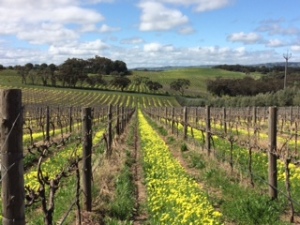 The next day we set off for Molly Dooker, which has a cultish following among its fans. These are big, burly wines with high alcohol, huge color and flavor extraction, and bags of character with clever eye-catching labels. Molly Dooker also has one of the most stunning vineyards we saw with the ocean almost visible on a clear day. My favorites here were the 2014 Blue Eyed Boy and the 2014 Velvet Glove (yes it comes in a velvet bag as well). The Velvet Glove is a hedonistic, densely textured wine with lush flavors of blackberry, licorice, clove, and chocolate. The overall style of Molly Dooker is a big hit in the U.S. where robust wines like these became popular in the wake of wine critic Robert Parker. Some of them are too over the top for me, but my palate has mellowed with age so maybe I’m missing something. Molly Dooker even has a sparkling wine in the Verdelho Girl on the Go with 15% alcohol. I don’t think I’ve encountered a sparkling wine with such high alcohol but it was well-integrated enough to not be apparent.
The next day we set off for Molly Dooker, which has a cultish following among its fans. These are big, burly wines with high alcohol, huge color and flavor extraction, and bags of character with clever eye-catching labels. Molly Dooker also has one of the most stunning vineyards we saw with the ocean almost visible on a clear day. My favorites here were the 2014 Blue Eyed Boy and the 2014 Velvet Glove (yes it comes in a velvet bag as well). The Velvet Glove is a hedonistic, densely textured wine with lush flavors of blackberry, licorice, clove, and chocolate. The overall style of Molly Dooker is a big hit in the U.S. where robust wines like these became popular in the wake of wine critic Robert Parker. Some of them are too over the top for me, but my palate has mellowed with age so maybe I’m missing something. Molly Dooker even has a sparkling wine in the Verdelho Girl on the Go with 15% alcohol. I don’t think I’ve encountered a sparkling wine with such high alcohol but it was well-integrated enough to not be apparent.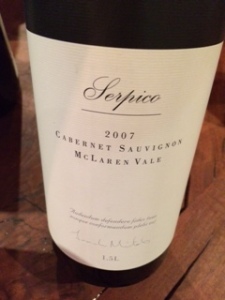 Our first evening was spent with Mitolo Wines which was one of my favorites of the trip from the overall perspectives of atmosphere, wine, and food. Italian varieties are making more of an appearance in parts of Australia and we got to try the 2016 Jester Sangiovese Rosé here as well as several Shiraz and Cabernet Sauvignon blends. I loved the 2010 Jester Cabernet Sauvignon as well as the fascinating 2007 Serpico Cabernet Sauvignon which was made from 100% dried Cabernet Sauvignon grapes (amarone style) adding a luxurious richness and mouthcoating texture to the plum, dried herb, and fig flavors. One of our charming hosts, a vineyard grower, pronounced this wine “Glamour” saying “this wine is a cracker!” I have to agree with him as it was one of my favorites of the trip. Incidentally, there were a lot of hilarious “lost in translation” moments between the Aussie accents and ours as well as some different vocabulary choices – make sure you know what people are saying before responding!
Our first evening was spent with Mitolo Wines which was one of my favorites of the trip from the overall perspectives of atmosphere, wine, and food. Italian varieties are making more of an appearance in parts of Australia and we got to try the 2016 Jester Sangiovese Rosé here as well as several Shiraz and Cabernet Sauvignon blends. I loved the 2010 Jester Cabernet Sauvignon as well as the fascinating 2007 Serpico Cabernet Sauvignon which was made from 100% dried Cabernet Sauvignon grapes (amarone style) adding a luxurious richness and mouthcoating texture to the plum, dried herb, and fig flavors. One of our charming hosts, a vineyard grower, pronounced this wine “Glamour” saying “this wine is a cracker!” I have to agree with him as it was one of my favorites of the trip. Incidentally, there were a lot of hilarious “lost in translation” moments between the Aussie accents and ours as well as some different vocabulary choices – make sure you know what people are saying before responding! The next day we spent a rainy morning and lunch at d’Arenberg with one of the more humorous personalities of the trip, Chester d’Arenberg. He is the one who walked us into the vineyards amidst pouring rain without batting an eye; his full commitment to winemaking readily apparent. He said that McLaren Vale has a climate somewhere between that of the North and South Rhone for those of us challenged by southern latitudes. We tried his well-known 2013 Dead Arm Shiraz, a fabulous sparkling wine called Polly, and an intriguing NV Nostalgia Rare Tawny Port (20.9% alcohol). Made in a semi-solera style (like Sherry) from mostly Grenache, this wine blends those of different ages (from 7 years old to 50 years old) to create the final wine. This wine was a deep bronze color tasting of roasted walnuts, dried fruit and figs, and toffee butter notes. He compared McLaren ports to Barossa saying that Barossa Ports tend to be richer, denser, and heavier with more pronounced tannins. Port-style wines are a popular thing in Australia with many well-made and inexpensive options.
The next day we spent a rainy morning and lunch at d’Arenberg with one of the more humorous personalities of the trip, Chester d’Arenberg. He is the one who walked us into the vineyards amidst pouring rain without batting an eye; his full commitment to winemaking readily apparent. He said that McLaren Vale has a climate somewhere between that of the North and South Rhone for those of us challenged by southern latitudes. We tried his well-known 2013 Dead Arm Shiraz, a fabulous sparkling wine called Polly, and an intriguing NV Nostalgia Rare Tawny Port (20.9% alcohol). Made in a semi-solera style (like Sherry) from mostly Grenache, this wine blends those of different ages (from 7 years old to 50 years old) to create the final wine. This wine was a deep bronze color tasting of roasted walnuts, dried fruit and figs, and toffee butter notes. He compared McLaren ports to Barossa saying that Barossa Ports tend to be richer, denser, and heavier with more pronounced tannins. Port-style wines are a popular thing in Australia with many well-made and inexpensive options.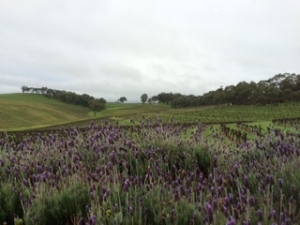 Our next stop was Yangarra, a beautiful spot with elegant and poised wines. Their vineyards lie in the most northern part of McLaren Vale where sea breezes and a cooler climate preside. Two knockout wines of the trip came from here in the 2013 Ironheart Shiraz ($105) and the 2013 High Sands Grenache ($130). I’m not usually fond of Grenache but this wine was ethereal with tense acidity, red and black fruit, complex spice, and dried herb flavors backed by atypically powerful tannins.
Our next stop was Yangarra, a beautiful spot with elegant and poised wines. Their vineyards lie in the most northern part of McLaren Vale where sea breezes and a cooler climate preside. Two knockout wines of the trip came from here in the 2013 Ironheart Shiraz ($105) and the 2013 High Sands Grenache ($130). I’m not usually fond of Grenache but this wine was ethereal with tense acidity, red and black fruit, complex spice, and dried herb flavors backed by atypically powerful tannins. 
 We started at Continuum which I saw a few years ago when it first broke ground on Pritchard Hill. Now sporting cellars and tasting rooms along with that still-stunning view to the Pacific Ocean, we tried the 2013 Continuum (66% Cabernet Sauvignon, 21% Cabernet Franc, 4% Merlot, and 9% Petit Verdot) as well as the 2014 Novicium (74% Cabernet Franc, 15% Petit Verdot, 10% Merlot, and 1% Cabernet Sauvignon). Novicium means “new or fresh wine” in Latin. The Continuum is meant for the long haul and is a dark dense beauty of all things black – cherry, earth, coffee, and cassis notes. The Novicium is drinking well now with floral, vegetal, and inky notes backed by firm acidity and smooth tannins. Tim Mondavi and his very accommodating family were most gracious as always and continue to produce knockout wines of elegance and balance.
We started at Continuum which I saw a few years ago when it first broke ground on Pritchard Hill. Now sporting cellars and tasting rooms along with that still-stunning view to the Pacific Ocean, we tried the 2013 Continuum (66% Cabernet Sauvignon, 21% Cabernet Franc, 4% Merlot, and 9% Petit Verdot) as well as the 2014 Novicium (74% Cabernet Franc, 15% Petit Verdot, 10% Merlot, and 1% Cabernet Sauvignon). Novicium means “new or fresh wine” in Latin. The Continuum is meant for the long haul and is a dark dense beauty of all things black – cherry, earth, coffee, and cassis notes. The Novicium is drinking well now with floral, vegetal, and inky notes backed by firm acidity and smooth tannins. Tim Mondavi and his very accommodating family were most gracious as always and continue to produce knockout wines of elegance and balance.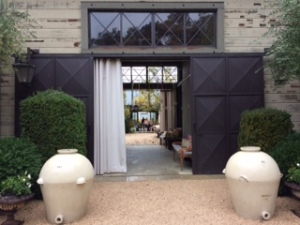 Our next stop was Hoopes which I’d not heard of but was thrilled to discover. We spent a scintillating lunch with Lindsay Hoopes and Tim Gaiser (Master Sommelier) learning about the estate as well as how to be better tasters. Try this trick the next time you drink wine: roll your eyes to the top of your head and try to smell at the same time. It doesn’t work so well as one apparently loses their sense of smell while doing this. Tim spent a lot of time tasting with a behavioral scientist and came away with all sorts of interesting findings including that good tasters move their eyes in the same pattern (usually to the left versus right) when in a groove tasting.
Our next stop was Hoopes which I’d not heard of but was thrilled to discover. We spent a scintillating lunch with Lindsay Hoopes and Tim Gaiser (Master Sommelier) learning about the estate as well as how to be better tasters. Try this trick the next time you drink wine: roll your eyes to the top of your head and try to smell at the same time. It doesn’t work so well as one apparently loses their sense of smell while doing this. Tim spent a lot of time tasting with a behavioral scientist and came away with all sorts of interesting findings including that good tasters move their eyes in the same pattern (usually to the left versus right) when in a groove tasting. The next day we set out for a tasting with Moone-Tsai amidst dense Napa fog which only added to the mystique and allure of these beautiful wines. Moone-Tsai’s vineyards are on Howell Mountain which has always been one of my favorite Napa appellations since my first visit to White Cottage Vineyards in 2011. I fell in love with it then and have remained enamored with wines from this AVA ever since. Howell Mountain wines are like the yin and yang. They are lush yet restrained, exuberant yet shy. It’s no surprise then that Howell Mountain was actually the first AVA in California based on these unique growing traits.
The next day we set out for a tasting with Moone-Tsai amidst dense Napa fog which only added to the mystique and allure of these beautiful wines. Moone-Tsai’s vineyards are on Howell Mountain which has always been one of my favorite Napa appellations since my first visit to White Cottage Vineyards in 2011. I fell in love with it then and have remained enamored with wines from this AVA ever since. Howell Mountain wines are like the yin and yang. They are lush yet restrained, exuberant yet shy. It’s no surprise then that Howell Mountain was actually the first AVA in California based on these unique growing traits.
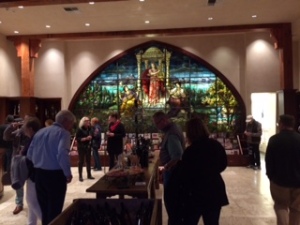 Our last winery of the trip was at Peju. This idyllic spot is located in Rutherford Valley within Napa. The winery sports a beautiful tower, stunning tasting room with Australian stone, and a nostalgic stained- glass window wall from Germany. It’s a lovely and tranquil place to visit and taste wine. Peju owns several other vineyards which allows them to make a wide variety of wines including Chardonnay, Sauvignon Blanc, Petit Verdot, Muscat, Zinfandel, Syrah, Merlot, several sparkling and rosé wines, as well as Cabernet Sauvignon.
Our last winery of the trip was at Peju. This idyllic spot is located in Rutherford Valley within Napa. The winery sports a beautiful tower, stunning tasting room with Australian stone, and a nostalgic stained- glass window wall from Germany. It’s a lovely and tranquil place to visit and taste wine. Peju owns several other vineyards which allows them to make a wide variety of wines including Chardonnay, Sauvignon Blanc, Petit Verdot, Muscat, Zinfandel, Syrah, Merlot, several sparkling and rosé wines, as well as Cabernet Sauvignon.
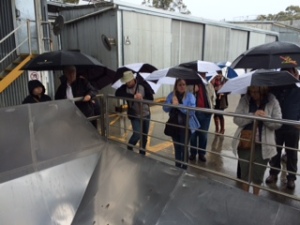

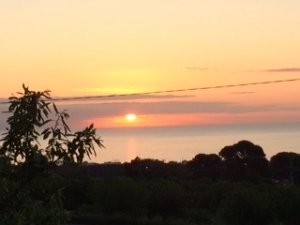 McLaren Vale offered nostalgic sunsets just miles from the Southern Ocean. Its wines are elegant and poised like the ones we sampled at Yangarra, Mitolo, and D’Arenburg. Molly Dooker, the famous cult winery with the catchy labels and powerhouse reds, was also fascinating with breathtaking vineyards and family-style hospitality. We also visited visit Shaw & Smith in the Adelaide Hills complete with wild kangaroos feeding on the outskirts of the tree-lined vineyard.
McLaren Vale offered nostalgic sunsets just miles from the Southern Ocean. Its wines are elegant and poised like the ones we sampled at Yangarra, Mitolo, and D’Arenburg. Molly Dooker, the famous cult winery with the catchy labels and powerhouse reds, was also fascinating with breathtaking vineyards and family-style hospitality. We also visited visit Shaw & Smith in the Adelaide Hills complete with wild kangaroos feeding on the outskirts of the tree-lined vineyard.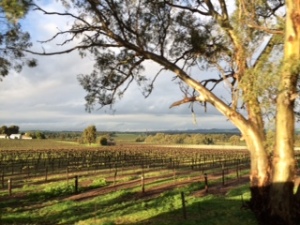
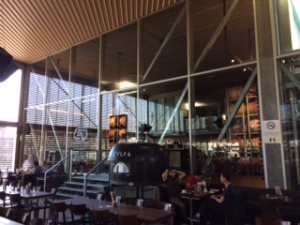
 Levantine Hill has a cozy winery with sweeping vineyard views and knockout Cabernet Sauvignon, Chardonnay, Shiraz, and sparkling wine. The 2013 Levantine Hill Syrah was very good with notes of tar, blackberry, violet and black pepper amid smooth tannins and a medium plus finish. My favorite here was the 2013 Yarra Valley Estate Cabernet Sauvignon which tasted of blackberry, black currant anise, purple flowers, and “leafiness”. “Leafiness” seems to be a term used in Australia for herbaceousness as I heard it a few times but is not to be confused with green or unripe fruit.
Levantine Hill has a cozy winery with sweeping vineyard views and knockout Cabernet Sauvignon, Chardonnay, Shiraz, and sparkling wine. The 2013 Levantine Hill Syrah was very good with notes of tar, blackberry, violet and black pepper amid smooth tannins and a medium plus finish. My favorite here was the 2013 Yarra Valley Estate Cabernet Sauvignon which tasted of blackberry, black currant anise, purple flowers, and “leafiness”. “Leafiness” seems to be a term used in Australia for herbaceousness as I heard it a few times but is not to be confused with green or unripe fruit. Fowles is located in the granite Strathbogie Ranges north of Yarra Valley. This is an enchanting boulder-strewn land with decomposed granite soils which play a key role in Fowles’ award-winning wines. Fowles also has a lamb farm and the estate has a lovely laid-back feel to it as any farm would. My favorite wine here was the 2012 Cabernet Merlot which was a great blend of both grapes’ best traits – blackberry, plum, mint, and cassis with lively tannins and medium bodied in nature.
Fowles is located in the granite Strathbogie Ranges north of Yarra Valley. This is an enchanting boulder-strewn land with decomposed granite soils which play a key role in Fowles’ award-winning wines. Fowles also has a lamb farm and the estate has a lovely laid-back feel to it as any farm would. My favorite wine here was the 2012 Cabernet Merlot which was a great blend of both grapes’ best traits – blackberry, plum, mint, and cassis with lively tannins and medium bodied in nature.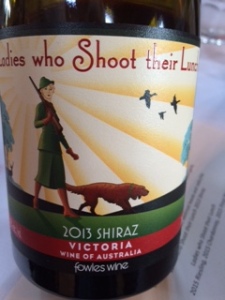 got even me to hit a target three times.
got even me to hit a target three times.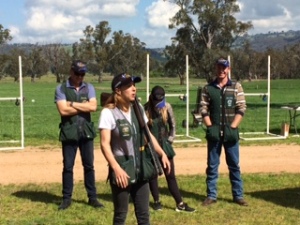
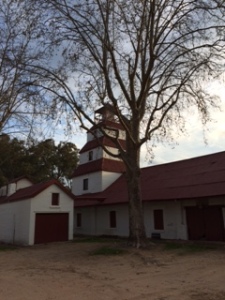 Tahbilk is the oldest winery in Victoria (one of 6 states in Australia) and has that old-world feel to it with dim cellars and 19th century architecture. This winery has outstanding Shiraz and Cabernet along with the largest stock of Marsanne (as well as some of the world’s oldest Marsanne vines) that I’ve come across. We actually did an entire flight of only Marsanne which most people have never heard of let alone tasted a full flight of. It was fascinating to see how this Northern Rhone variety, rarely seen on its own, evolves with time into rich complexity. This was evident in the 1996 vintage which was a golden amber color and viscous in body with nuts, marmalade, and honey. In contrast, the much younger 2016 Marsanne was a pale lemon color with lime, citrus, and tropical pineapple flavors in comparison. Note that Australia has already completed their 2016 harvest because they are half a season ahead of us so don’t be surprised if you see Aussie wines (or any other from the Southern hemisphere) already on the 2016 vintage.
Tahbilk is the oldest winery in Victoria (one of 6 states in Australia) and has that old-world feel to it with dim cellars and 19th century architecture. This winery has outstanding Shiraz and Cabernet along with the largest stock of Marsanne (as well as some of the world’s oldest Marsanne vines) that I’ve come across. We actually did an entire flight of only Marsanne which most people have never heard of let alone tasted a full flight of. It was fascinating to see how this Northern Rhone variety, rarely seen on its own, evolves with time into rich complexity. This was evident in the 1996 vintage which was a golden amber color and viscous in body with nuts, marmalade, and honey. In contrast, the much younger 2016 Marsanne was a pale lemon color with lime, citrus, and tropical pineapple flavors in comparison. Note that Australia has already completed their 2016 harvest because they are half a season ahead of us so don’t be surprised if you see Aussie wines (or any other from the Southern hemisphere) already on the 2016 vintage.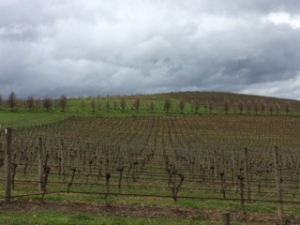
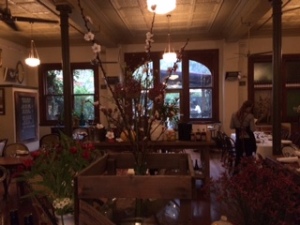

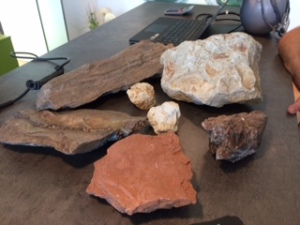
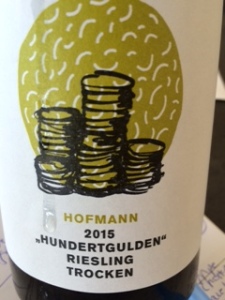
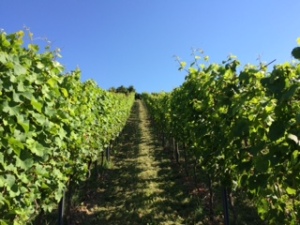


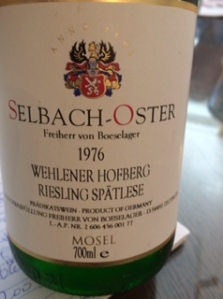
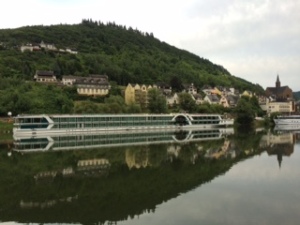


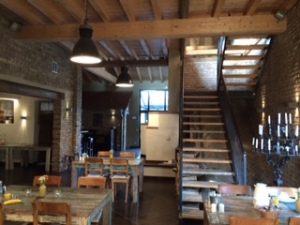 Our trip started at the Hinterconti Bed and Breakfast in Bretzenheim, a short drive from Bingen and Reh Kendermann’s property in Rheinhessen. A lovelier host and cozier accommodations would be hard to find. Kristina, the owner, is a bundle of warmth and energy with great attention to detail which is plainly obvious in her modern oversized rooms, the beautifully rustic and chic bar and dining areas, and her amazing wine selections which she handpicks herself. She regularly visits local wineries and selects her favorites for the bed and breakfast.
Our trip started at the Hinterconti Bed and Breakfast in Bretzenheim, a short drive from Bingen and Reh Kendermann’s property in Rheinhessen. A lovelier host and cozier accommodations would be hard to find. Kristina, the owner, is a bundle of warmth and energy with great attention to detail which is plainly obvious in her modern oversized rooms, the beautifully rustic and chic bar and dining areas, and her amazing wine selections which she handpicks herself. She regularly visits local wineries and selects her favorites for the bed and breakfast. 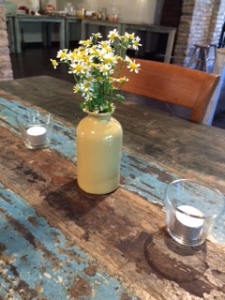
 Bretzenheim itself is also charming. It is a tiny town, so quiet at night that you can hear voices down the road. Grapevines form arbors over many of the streets and old red brick walls line the sidewalks. Biking and hiking trails abound in Germany and the one leading out of Bretzenheim took us to a stunning mustard-colored field of swaying wheat.
Bretzenheim itself is also charming. It is a tiny town, so quiet at night that you can hear voices down the road. Grapevines form arbors over many of the streets and old red brick walls line the sidewalks. Biking and hiking trails abound in Germany and the one leading out of Bretzenheim took us to a stunning mustard-colored field of swaying wheat. 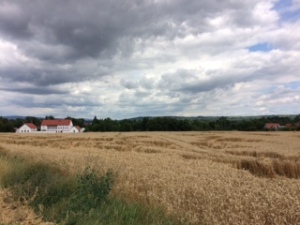
 had more time to investigate them.
had more time to investigate them.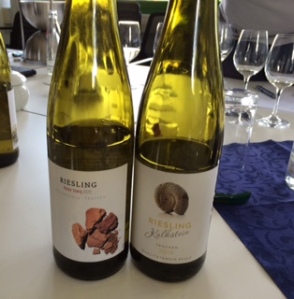 The first flight was a fascinating set of two Sauvignon Blancs (yes Germany does very well with this varietal) and a Grauerburgunder (Pinot Gris). The 2015 Sauvignon Blanc Kalkstein from Pfalz (a region further south) had zippy acid, savory herb aromas, and classic flavors of grapefruit and lime. Made from Kalkstein (limestone soil), I initially thought it was from New Zealand due to its exuberant profile. The other Sauvignon Blanc was Reh Kendermann’s 2015 Island Bay from Marlborough, NZ which was paler in lemon color with bright citrus fruit, zesty acid, and grassy flavors.
The first flight was a fascinating set of two Sauvignon Blancs (yes Germany does very well with this varietal) and a Grauerburgunder (Pinot Gris). The 2015 Sauvignon Blanc Kalkstein from Pfalz (a region further south) had zippy acid, savory herb aromas, and classic flavors of grapefruit and lime. Made from Kalkstein (limestone soil), I initially thought it was from New Zealand due to its exuberant profile. The other Sauvignon Blanc was Reh Kendermann’s 2015 Island Bay from Marlborough, NZ which was paler in lemon color with bright citrus fruit, zesty acid, and grassy flavors.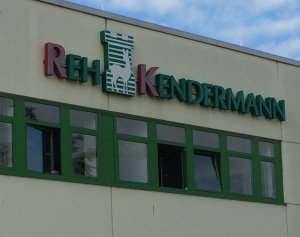
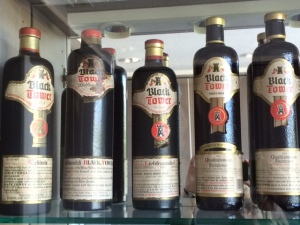 Their biggest brand of all is Black Tower which is also the number one brand from Germany, selling over 15 million bottles annually. This long running brand was founded in 1967 in a black ceramic bottle. There have been many bottle iterations over the past 49 years but the black bottle has always been preserved in some way. In 2010, there was another bottle change to make it appear more contemporary (now only the top half of the bottle is black) and the logo itself was feminized a bit in 2016 to look softer. Young people think Black Tower is an old fashioned brand which is why some of the above changes were made. A special campaign focused on millennials (the WOW campaign) is currently underway in an effort to attract this key demographic group to Black Tower for the first time. The U.K., Ireland, Canada, and Scandinavia are the biggest markets for Black Tower.
Their biggest brand of all is Black Tower which is also the number one brand from Germany, selling over 15 million bottles annually. This long running brand was founded in 1967 in a black ceramic bottle. There have been many bottle iterations over the past 49 years but the black bottle has always been preserved in some way. In 2010, there was another bottle change to make it appear more contemporary (now only the top half of the bottle is black) and the logo itself was feminized a bit in 2016 to look softer. Young people think Black Tower is an old fashioned brand which is why some of the above changes were made. A special campaign focused on millennials (the WOW campaign) is currently underway in an effort to attract this key demographic group to Black Tower for the first time. The U.K., Ireland, Canada, and Scandinavia are the biggest markets for Black Tower.

 Another creative thing that Reh Kendermann does exceptionally well is to issue collectors bottles which they do 3-5 times a year with all kinds of themes from special events to seasonal commemorations. The bottles are simply beautiful and so eye-catching with vivid colors and lovely designs done by their own in-house label designer. Production is around 10,000 bottles.
Another creative thing that Reh Kendermann does exceptionally well is to issue collectors bottles which they do 3-5 times a year with all kinds of themes from special events to seasonal commemorations. The bottles are simply beautiful and so eye-catching with vivid colors and lovely designs done by their own in-house label designer. Production is around 10,000 bottles.
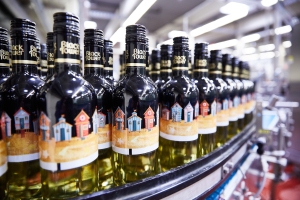 Quality Control is of utmost concern at Reh Kendermann and they have an incredibly advanced, highly automated winery. They keep samples of every single bottle batch made (1 case batch per bottling) which are then stored in a warehouse. These are required to be kept for 2 years but Reh Kendermann keeps them for 3. If there are customer complaints, they can then compare the sample to the issue and see if the issue was from Reh or in the storage/transport since leaving Reh. Aging tests are also run on these samples to see how the wines evolve. There have been no justified callbacks since 2000. “Always test the test” is their motto.
Quality Control is of utmost concern at Reh Kendermann and they have an incredibly advanced, highly automated winery. They keep samples of every single bottle batch made (1 case batch per bottling) which are then stored in a warehouse. These are required to be kept for 2 years but Reh Kendermann keeps them for 3. If there are customer complaints, they can then compare the sample to the issue and see if the issue was from Reh or in the storage/transport since leaving Reh. Aging tests are also run on these samples to see how the wines evolve. There have been no justified callbacks since 2000. “Always test the test” is their motto.
